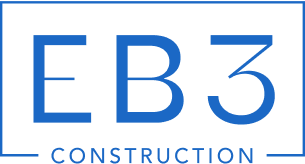In construction, selecting the right subcontractors is crucial to a project’s success. Their specialized skills, reliability, and commitment to safety and quality standards significantly influence project timelines, costs, and overall outcomes. At EB3 Construction, we recognize that subcontractor vetting is more than a routine task—it’s a vital safeguard for the entire project.
We take subcontractor vetting seriously. Our comprehensive process ensures every subcontractor has the necessary qualifications, current licenses, comprehensive insurance, and excellent safety records. This careful screening allows us to operate confidently within legal frameworks and maintain the highest industry standards. Neglecting this critical step can lead to significant and widespread consequences.
Imagine breaking ground on a multi-million dollar development, only to discover midway that a key subcontractor lacks proper certifications or has a history of safety issues. The repercussions could be severe—legal disputes, work stoppages, escalating costs, and potential injuries. By investing time and effort in thorough vetting early on, we protect our clients from these risks and ensure smooth project execution. Given today’s stringent regulations within the construction industry, due diligence is not just advisable—it’s essential for project success and our reputation as a trusted general contractor.
How Do You Verify a Subcontractor’s Credentials and Performance History?

Verifying a subcontractor’s credentials and performance history is a crucial step in managing project risk. We take a systematic approach to evaluate potential partners:
Request and Verify References
We start by requesting references from the subcontractor’s previous clients and projects. We contact these references directly to inquire about the subcontractor’s work quality, timeliness, and professionalism. A subcontractor’s reluctance or refusal to provide references is a significant red flag in our evaluation process.
Check Licenses and Certifications
We thoroughly review all licenses, accreditations, and certifications provided by the subcontractor. Our team validates the authenticity of these credentials with the issuing authorities to ensure they are current and in good standing.
Examine Safety Records
Safety is paramount in our industry. We closely examine a subcontractor’s safety history by reviewing their Experience Modification Rate (EMR) and OSHA compliance records. A strong safety record indicates a well-managed operation.
Evaluate Past Project Performance
We assess the subcontractor’s portfolio of past projects, focusing on:
- Project quality and outcomes
- Adherence to schedules and deadlines
- Ability to work within budget constraints
- Collaborative approach with other project stakeholders
Research Public Records
Our due diligence process includes searching for any public records of complaints, disputes, or legal issues involving the subcontractor. This can provide valuable insights into their business practices and reliability.
Seek Industry Feedback
We connect with other contractors and industry professionals who have worked with the subcontractor to gather unbiased feedback on their performance and reputation.
Review Online Presence
Social media and online reviews can offer additional perspectives on a subcontractor’s reputation. We analyze this information while being mindful of its potential limitations.
By systematically following this verification process, we build a comprehensive profile of each subcontractor’s capabilities and track record. This thorough approach helps us identify reliable partners who can contribute to the success of our projects while minimizing potential risks.
What Financial Factors Should You Assess When Vetting Subcontractors?
When evaluating potential subcontractors, assessing their financial health is crucial. A subcontractor’s financial stability directly impacts their ability to fulfill project commitments, procure materials on time, and maintain a stable workforce. As general contractors, we carefully examine several key financial factors to ensure we’re partnering with reliable and financially sound subcontractors.
Key Financial Documents to Request
We request and review the most recent year’s financial statements for any subcontractor we’re considering. For larger or more complex projects, we may also request:
- Two years of financial statements
- Information on annual contractor volume
- Total sales figures
- Net worth details (may require a confidentiality agreement)
We involve our certified public accountant in reviewing these documents to ensure a thorough analysis.
Critical Financial Metrics to Evaluate
When assessing a subcontractor’s financial statements, we pay close attention to these key metrics:
- Current ratio: Measures short-term liquidity and ability to cover immediate obligations
- Quick ratio: A more stringent measure of liquidity, excluding inventory
- Debt-to-equity ratio: Indicates the level of financial leverage and risk
- Overhead expenses: Assesses efficiency in managing indirect costs
- Total revenues: Provides insight into the scale of operations
These metrics help us gauge the subcontractor’s overall financial health and stability.
Red Flags to Watch For
During our financial assessment, we remain vigilant for warning signs that could indicate potential problems:
- Poor or inconsistent cash flow
- Excessive debt levels
- Declining income or profit margins
- Unusually high overhead costs
- Overreliance on a single client or project
Any of these red flags warrant further investigation and may impact our decision to work with a particular subcontractor.
Assessing Procurement Ability
A subcontractor’s financial position directly affects their ability to procure necessary materials and equipment. We evaluate their relationships with suppliers, credit terms, and purchasing power to ensure they can obtain required resources without delays.
Bonding Capacity Considerations
For larger projects, we also assess a subcontractor’s bonding capacity. This provides additional assurance of their financial stability and ability to complete the work as contracted.
By thoroughly evaluating these financial factors, we can make informed decisions about which subcontractors to partner with, minimizing financial risks to our projects and ensuring smoother project execution. Remember, a subcontractor’s financial health is just as critical as their technical capabilities when it comes to successful project delivery.
How Do You Evaluate a Subcontractor’s Workforce and Safety Practices?

When evaluating subcontractors for a construction project, we thoroughly assess both their workforce capabilities and safety practices. This dual focus ensures high-quality work and reduces risks on the job site. Here are the key areas we examine:
Workforce Evaluation
We closely examine the subcontractor’s team composition and qualifications:
- Employment status: Are the workers full-time employees or temporary hires?
- Experience level: What is the overall construction experience of the crew?
- Staffing capacity: Does the company have enough qualified professionals to manage our project scope?
- Skills and certifications: What specialized training or certifications do team members have?
Safety Protocols and Training
A strong safety culture is crucial. We confirm that subcontractors have:
- Comprehensive safety protocols aligned with OSHA standards
- Regular safety training programs for all employees
- A designated safety officer or manager overseeing compliance
- Clear communication channels for reporting safety concerns
- Documented procedures for accident investigation and prevention
Safety Performance Metrics
We request and analyze key safety indicators, including:
- Experience Modification Rate (EMR): This insurance-based metric provides insight into past safety performance
- OSHA recordable incident rates
- History of safety violations or citations
- Safety awards or recognitions
Insurance and Bonding
Proper coverage is essential to protect all parties. We ensure subcontractors maintain:
- Adequate general liability insurance
- Worker’s compensation coverage
- Appropriate bonding for the project scope
We reject any subcontractor failing to meet these minimum safety and insurance requirements to avoid significant liability risks if issues arise during the project.
On-Site Safety Management
Beyond documentation, we explore how subcontractors actively uphold safety standards in the field:
- Frequency of safety inspections and audits
- Processes for identifying and mitigating new hazards
- Disciplinary procedures for safety violations
- Methods for fostering a proactive safety culture among workers
By thoroughly vetting subcontractors in these areas, we form project teams committed to safety, quality, and successful outcomes. This diligence safeguards workers, ensures compliance, and ultimately delivers better results for our clients.
What Should Be Included in Your Subcontractor Agreement?

A thorough subcontractor agreement is more than just a formality—it’s a risk management tool. At EB3 Construction, we use these contracts to clarify responsibilities, reduce ambiguity, and keep every project moving forward without avoidable setbacks. Here’s what we make sure to include—and why each element matters.
Detailed Scope of Work
This section outlines exactly what the subcontractor is responsible for—from demolition and framing to electrical rough-ins or finish carpentry. A well-defined scope prevents scope creep, ensures accountability, and protects both the contractor and subcontractor from misunderstandings. We often include drawings, material specs, and task checklists as attachments.
Resource Responsibilities
Who’s bringing what to the job site? This section clearly states which party provides labor, equipment, or materials. For example, on HVAC installs, the subcontractor might supply the crew and tools, while EB3 provides the rooftop units. This avoids costly delays caused by misaligned assumptions.
Payment Schedule and Milestones
We tie payments to progress checkpoints—such as “concrete slab poured” or “framing completed”—rather than calendar dates. This ensures payments reflect actual work delivered and incentivizes on-time completion. Payment terms also include documentation requirements like lien waivers and signed inspections.
Change Order Procedures
Changes are inevitable. That’s why we spell out how they’ll be handled—requiring all change requests to be submitted in writing, priced, and approved before work proceeds. This protects against unauthorized changes and surprise costs, while keeping the project budget on track.
Safety and Compliance
We specify required safety training, PPE usage, and OSHA compliance measures. On active sites, subcontractors must submit safety plans and designate a safety officer. This section also covers site access rules, hot work permits, and any project-specific environmental requirements.
Dispute Resolution Process
No one wants disputes, but they happen. Our agreements outline a step-by-step resolution process, starting with internal discussions and escalating to mediation or arbitration if needed. This helps preserve relationships and keeps minor issues from delaying progress.
Termination Conditions
We define the specific circumstances under which either party can terminate the contract. These might include failure to meet deadlines, safety violations, or nonpayment. Including this language helps both sides exit professionally if the working relationship becomes unsustainable.
Quality Control Standards
Every subcontractor must meet EB3’s performance standards. We include inspection checklists, testing protocols, and acceptance criteria for key phases—such as concrete compressive strength or waterproofing integrity—to ensure work meets both spec and code.
Warranty Terms
This section outlines the length and scope of the subcontractor’s workmanship warranty. It also clarifies what happens if defects arise—who fixes it, how quickly, and whether additional costs are reimbursed. We align this with owner warranty expectations whenever possible.
Including these elements in every subcontractor agreement helps us protect timelines, budgets, and relationships. A clear, enforceable contract removes guesswork from the equation and builds a professional framework everyone can trust.
Verbal agreements might seem quicker, but they leave too much to chance. At EB3 Construction, we use detailed written contracts for every subcontractor—no matter the trade or project size. It’s how we keep jobs running smoothly and protect everyone involved.
Conclusion: Building Strong Subcontractor Relationships for Project Success
Thorough vetting of subcontractors is essential for project success, risk mitigation, and maintaining our company’s reputation. By carefully evaluating credentials, financial stability, workforce quality, and safety practices, we can build relationships with reliable partners who enhance our projects rather than create problems. We establish clear communication channels and expectations through comprehensive written agreements.
At EB3 Construction, hiring a subcontractor is akin to hiring an employee—we seek partners who will represent our business well without adding stress or financial burden. The time invested in proper vetting pays dividends through successful projects, satisfied clients, and long-term business relationships. Our rigorous selection process allows us to consistently deliver high-quality work while managing risks effectively.
Building strong subcontractor relationships based on trust, open communication, and shared goals creates a solid foundation for project success. Collaborating with proven, reliable trade partners positions us better to meet deadlines, control costs, and exceed client expectations. The investment in thorough vetting and relationship-building ultimately strengthens our reputation as a top-tier general contractor capable of executing complex projects.
By prioritizing thorough subcontractor vetting and fostering productive long-term partnerships, EB3 Construction continues to enhance our ability to deliver exceptional results for our clients. We recognize that our success is intertwined with the success of our subcontractor partners. Through ongoing evaluation and collaboration, we cultivate a network of skilled trades that enables us to take on increasingly ambitious projects with confidence.
To learn more about EB3 Construction’s approach to subcontractor management and how we can bring our expertise to your next project, contact our team today.




